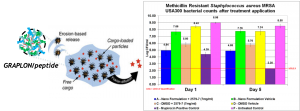Nanomaterials for Antimicrobial Drug Delivery to Wounds
Infections that are able to penetrate soft tissues, such as those in combat wounds, burns, and implanted medical hardware, are particularly challenging to treat. The tissue microenvironment promotes biofilm formation and, following therapy, development of multidrug resistance (MDR). We aim to develop a multifunctional precision nanomedicine for the treatment of MDR biofilm infections in these applications. Our approach features polyanionic surfactants (PS) that self-assemble with cationic antimicrobial peptides and amine-functional (e.g. aminoglycoside) antibiotics to form nanocomplexes whose properties in solution can be tailored to be favorable for delivery. In addition to encapsulating and controlling the release kinetics of cationic drugs, the PS are designed to disrupt biofilms through surfactant interfacial interactions with the biofilm’s extracellular polymeric substances (EPS). We have used these PS to encapsulate novel lipopeptide antibiotics and incorporated them into hydrogels with biocompatible biopolymers. These nanostructured gels exhibit effective topical antimicrobial activity in a porcine partial thickness infected wound model. We are also developing “nanospray” formulations that allow administration without direct contact, in order to lessen the high degree of pain associated with contact-based administration.
